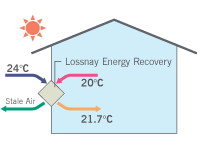Why choose Lossnay - Fresh Air Energy Recovery?
Draws in fresh outdoor air
Circulates the air continuously
Retains heat
Assists moisture control
Helps keep heating bills down
World leader in ventilation systems, Mitsubishi Electric’s patented Fresh Air Energy Recovery System is available in New Zealand. Because Lossnay uses fresh air (not attic air) to ventilate your home, you get the best of both worlds - fresh air into the home whilst reducing dampness - and without the excessive added heating costs that most alternative systems cannot prevent.
Lossnay ensures the air in your home stays fresher, cleaner and drier. By recovering indoor heat you will also increase energy efficiency.
What Lossnay Fresh Air Ventilation System is best suited for my application?
| Domestic VL-220CZGV-E | Commercial LGH-25~200RVX | |
|---|---|---|
| Application | Small to medium home. Up to your average sized 4 bedroom home |
Small to large commercial spaces, offices, shops and large homes. |
| Heat Exchanger Core Technology | Heat Recovery Can recover heat or cooling energy from extracted room air and also heat energy from moist air in areas such as bathrooms and kitchens. |
Energy Recovery Can recover heat or cooling energy from extracted room air only. |
| Extract Moist Air Can recover heat from moist air in areas such as bathrooms and kitchens. |
||
| Bypass Mode Allows the extracted air to bypass the heat exchanger core. |
Optional extra. |
Built in. |
| Interlock with Ducted Heat Pump System |
||
| Interlock with City Multi VRF |

Why is ventilation important?
Ventilation is important to maintain air quality and remove moisture in your home creating a healthy environment. Home design and improvements have meant that homes are becoming more air tight and easier to heat, this in turn has increased the need for adequate ventilation.

Old vs. new ventilation systems
There are two types of Ventilation systems available in New Zealand:
- Old ‘positive’ pressure roof cavity ventilation systems
- New Lossnay ‘balanced’ pressure fresh air heat recovery ventilation systems
Energy and cost savings
The Lossnay Fresh Air Ventilation system works by extracting stale air from inside your house to remove damp, odours, dust, bacteria and gasses. This air is then replaced with allergen reduced fresh air from outside (unlike some systems that recycle it from the dust-filled attic). Where Lossnay gets really clever is with its environmentally friendly 'Energy Recovery' system. Put simply, energy within the stale air can be recovered and used to pre-heat or pre-cool the fresh air being vented in. So it warms the fresh air in winter, and cools it in summer.
Energy recovered in Winter

If outdoor air is 7˚C and the indoor air is at 20˚C, then the supply air from the Lossnay would be 14.5˚C. The supply air only needs to be heated by 5.5˚C†, to reach 20˚C comfort temperature not 13˚C, thus saving energy and money. With conventional ventilation systems, this energy would normally be wasted!
Energy recovered in Summer

If the outdoor air is 24˚C and the indoor air is 20˚C, then the supply air would be 21.7˚C. In summer the house will feel clean and fresh, even if you leave the house locked up for a long period of time.
Show More
† Note: Ventilation systems do not create heat. During winter Mitsubishi Electric recommends that Lossnay Fresh Air Energy Recovery Ventilation is used in conjunction with a Mitsubishi Electric Heat Pump. This will ensure a complete home solution providing both fresh air and energy efficient heating. * Supply temperatures may fluctuate with humidity.
Preset your Comfort
Lossnay’s intelligent preset comfort zone ensures that air warmer than 28°C in summer, or cooler than 8°C in winter will not be introduced. (Settings can be adjusted by installer).
